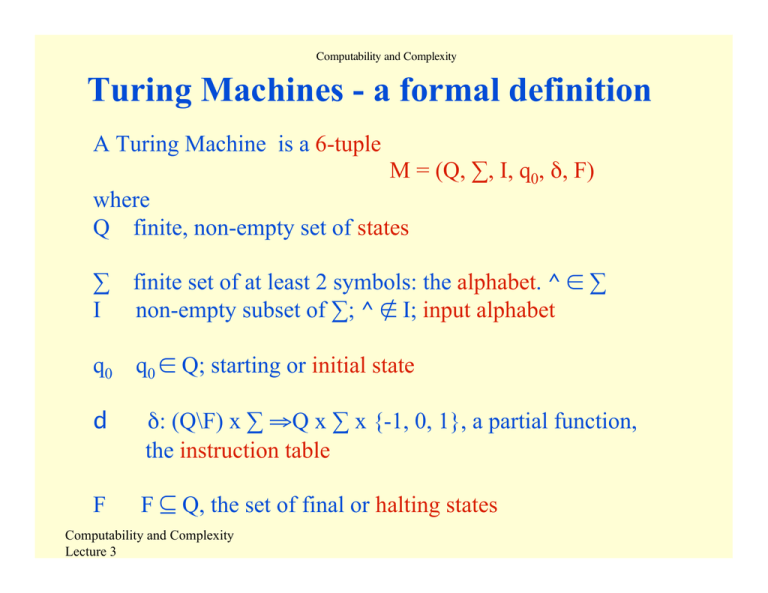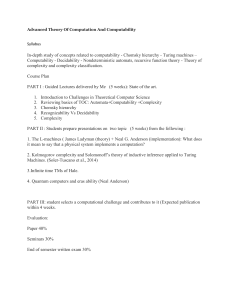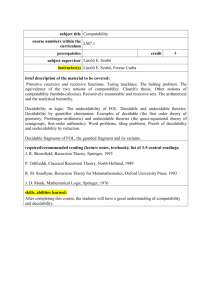Turing Machines - a formal definition
advertisement

Computability and Complexity
Turing Machines - a formal definition
A Turing Machine is a 6-tuple
M = (Q, ∑, I, q0, δ, F)
where
Q finite, non-empty set of states
∑ finite set of at least 2 symbols: the alphabet. ^ ∈ ∑
I
non-empty subset of ∑; ^ ∉ I; input alphabet
q0
q0 ∈ Q; starting or initial state
d
δ: (Q\F) x ∑ ⇒Q x ∑ x {-1, 0, 1}, a partial function,
the instruction table
F
F ⊆ Q, the set of final or halting states
Computability and Complexity
Lecture 3
Computability and Complexity
Some notation:
A word is a string of symbols eg. lecture^room
..
..for an alphabet
(set of symbols) ∑
a word of ∑* is a finite string of elements of ∑.
∑* = all words of ∑
ε is the empty word; ε ∈ ∑* for any ∑.
We represent concatenation of words v and w by v.w
The value computed by the TM, M on input w is fM(w).
If M does not Halt & Succeed on input w, then fM(w) is undefined.
Computability and Complexity
Lecture 3
Computability and Complexity
The TM tape contents:
The input alphabet is I; ^ ∉ I.
w0
w1
w2
w3
TM Input is a word of I*
w4
^
^
^
^
Eg. a tape with contents w = w0w1w2w3w 4∈ I* at start of TM run
There are no blanks (^ ) in the input w..
the input word is terminated by the first ^ on the tape when
the TM starts.
If all the wi are blank, we have the empty input, ε.
Computability and Complexity
Lecture 3
Computability and Complexity
∑ is the whole or internal alphabet of the TM.
The input alphabet I is a subset of ∑: I ⊆ ∑ and ^ ∈ ∑.
the TM Output is a word w' of ∑*..without blanks (^).
It starts at square 0 and
ends just before the first blank, ^, on the tape
when the TM halts and succeeds.
(otherwise it is not defined).
Not all words of ∑* are necessarily valid outputs.
Not all symbols of ∑* are necessarily valid outputs.
Computability and Complexity
Lecture 3
Computability and Complexity
a Turing Machine example..
M = ({q0, q1, q2}, {1, ^}, {1}, q0, δ,
Q
∑
state set
alphabet
I
input
alphabet
{q2})
halting state
delta function
initial state
δ-function:
δ (q0, 1) = (q1, ^, 1)
δ (q0, ^) = (q2, ^, 0)
δ (q1,1) = (q0, 1, 1)
possible inputs: 11111^^^…
1111^^^…
111^^^…
Computability and Complexity
Lecture 3
what does this TM do?
Computability and Complexity
..a TM example
δ (q0, 1) = (q1, ^, 1)
δ (q0, ^) = (q2, ^, 0)
δ (q1,1) = (q0, 1, 1)
W2 :
q0
q1
q0
q1
111^^^…
Halt & Fail
111^^
^11^^
^11^^
^1^^^
W1 :
q0
q1
q0
q1
q0
q2
1111^^
1111^^
^111^^
^111^^
^1^1^^
^1^1^^
^1^1^^
Halt & succeed
the TM M starts in state q0 with the head over square 0..
if M is in state q0:if M reads a 1 it • writes a ^
• moves right 1 square on the tape
• goes into state q1
otherwise, M reads a ^: it • writes a ^
• does not move along the tape
• goes into state q2
if M is in state q1:if M reads a 1 it• writes a 1
• moves right 1 square along the tape
• goes into state q0
otherwise M halts and fails: no applicable instruction
if M is in state q2 it
• halts and succeeds
Computability and Complexity
Lecture 3
Computability and Complexity
another Turing Machine example..
design a TM, M = (Q, ∑, I, q0, δ, F) which evaluates the function
head:
I = {a,b}, ∑ = {a, b, ^}
head(w) = s, where s∈ I, w1∈ I* and w = s.w1
head(ε) is undefined
δ (q0, a) = (q1, a, 1)
δ (q0, b) = (q1, b, 1)
δ (q1, a) = (q2, ^, 0)
δ (q1, b) = (q2, ^, 0)
δ (q1, ^) = (q2, ^, 0)
Computability and Complexity
Lecture 3
b a b ^ ^ ^ ^ ….
q0 bab^^^…
q1 bab^^^…
q2 b^b^^^…
Halt and Succeed
Computability and Complexity
Summary
We have seen a formal definition of a Turing
Machine:
M = (Q, ∑, I, q0, δ, F)
where
Q finite, non-empty set of states
∑ finite set of at least 2 symbols: the alphabet. ^ ∈ ∑
I non-empty subset of ∑; ^ ∉ I; input alphabet
q0 q0 ∈ Q; starting or initial state
δ
δ: (Q\F) x ∑ ⇒Q x ∑ x {-1, 0, 1}, a partial function,
the instruction table
F F ⊆ Q, the set of final or halting states
and examples of simple TMs to
- determine whether a number is odd/even
- return the Head of the input word.
Computability and Complexity
Lecture 3
Computability and Complexity
Design a Turing Machine to implement the Tail function
Q = {q0, ..
a
b
}, F = { }, ∑ = {a,b,^}.
a
Computability and Complexity
Lecture 3
b
^
^ ^ ^
^




